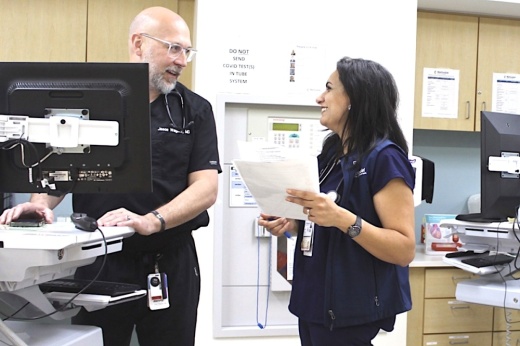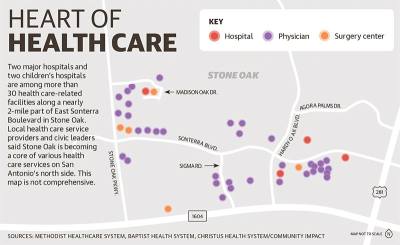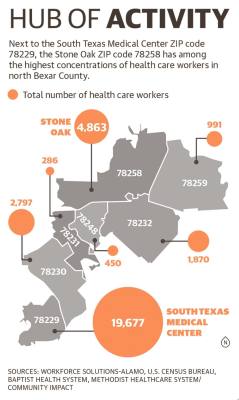Data and capital projects show Stone Oak plays a big part in San Antonio’s growing health care industry.
Workforce Solutions Alamo data shows the Stone Oak ZIP code 78258 has one of the highest local concentrations of physical and mental health care workers in Bexar County outside of 78229, where the South Texas Medical Center—with its plethora of hospitals, outpatient clinics and providers—resides.
“I’m pleased to see a lot of that health care growth in the north central area and in District 9,” said John Courage, the City Council member for District 9, which includes Stone Oak. “It reflects the growth of Stone Oak and the surrounding area of the last 20 to 30 years. In that time, I’ve seen real change in population and in the diversity of the population.”
The growth of Stone Oak’s health care sector is reflective of the trend in health care happening across the San Antonio area.
According to the San Antonio Chamber of Commerce’s latest biannual health care economic impact report, released in December, the overall economic effect, payrolls and workforce numbers in local health care continue to rise or remain steady.
The economic impact of San Antonio’s health care and bioscience industry in 2021 totaled $44.1 billion, a 48% increase over 10 years, the report states.
North San Antonio community leaders said Stone Oak’s flourishing health care sector—with two major hospitals, two children’s hospitals, and numerous general and specialty providers—reflects the area’s growth and contributes to the city’s total health care economic output.
They also said health care offerings available in Stone Oak set the stage for more expansions and other capital projects at neighborhood hospitals to accommodate even more growth.
”Growth of health care here is warranted, and it reflects the needs of people here,” Courage said.
Hospitals anchor growth
Leaders of North Central Baptist Hospital and Methodist Stone Oak Hospital—both located in Stone Oak—agreed with the chamber report’s assessment that health care providers have followed the area’s residential and commercial boom for 30-plus years.
According to the Methodist Healthcare System, Methodist Stone Oak has undergone several expansions since opening in 2009, including going from having 140 beds in 2018 to 242 beds alongside 13 operating suites, another 42 beds for acute care and rehabilitation, and a fertility clinic.
Methodist Stone Oak CEO Jeff Wilson said his facility as well as North Central Baptist Hospital serves a diverse number of patients who live throughout north central San Antonio, north Bexar County and some residents of nearby Comal County.
Wilson added the population of the Stone Oak ZIP code 78258, which grew from 40,586 residents in 2010 to 51,073 in 2020, has propelled a continuing infusion of health care offerings into the neighborhood.
“If you drive along Loop 1604 and US 281, the thing that has really changed in the past five years is the increase in the number of multifamily dwellings, such as apartment complexes and townhouse communities,” Wilson said.
Wilson said many people who moved to Stone Oak when it was beginning to develop 25-30 years ago aged in place and, as a result, are moving their parents closer to home and require medical services, such as vascular and cardiological care as well as rehabilitation and assisted-living opportunities in the area.
Wilson also said Stone Oak keeps attracting young families who require their own health care services, such as pediatrics and general family practitioners, in the neighborhood.
“Health care is local. Patients like to be seen by someone in their own community. The number of physicians opening up practices in Stone Oak has been robust,” Wilson said, referring to services that include urgent care clinics and home health care programs.
Bill Waechter, president and CEO of North Central Baptist Hospital, agreed with Wilson about Stone Oak’s continuing population growth fueling the neighborhood’s health care industry.
North Central Baptist Hospital, which opened in 1991 and has since undergone numerous expansions, features more than 400 beds, and is home to a children’s hospital and Baptist Orthopedic Hospital.
Waechter said North Central Baptist Hospital was one of the first major nonresidential structures built in Stone Oak, and from there the hospital’s staff has seen the community’s medical needs evolve over time.
“It is like a mini-[South Texas Medical Center] here now,” Waechter said. “It used to be, if you lived in Stone Oak, you had to travel for any kind of major medical care. That’s really no longer the case.”
Accommodating future growth
Waechter and Wilson said their respective hospitals are planning an increasing number of ways of providing patients with comprehensive care well into the future.
Methodist Stone Oak will begin a 10-month, $8.5 million project in July. The project involves the construction of a catheter laboratory, the addition of three new operating rooms, and three catheter preparation and recovery spots in existing hospital space, Wilson said.
Wilson also said the Methodist Stone Oak angiography lab is being remodeled to better serve patients who undergo examinations of their arteries, veins or heart chambers.
“We are still growing,” Wilson said.
Waechter said North Central Baptist Hospital is planning its own future expansions, including a dedicated heart health center and a hybrid vascular operating room that would be outfitted with the same camera equipment typically found in a catheter lab.
North Central Baptist Hospital has previously undergone multiple upgrades, including the opening of a nearly $3 million revamped women’s health service area in summer 2022, Waechter said. This May, North Central Baptist Hospital officials announced the opening of two new robotic surgery suites in the women’s services area.
“It was a needed service. It was something that there was demand for, and we were able to open that up,” Waechter said of the women’s services area.
Civic leaders, including Danny Zimmermann, North San Antonio Chamber of Commerce board chair, said Stone Oak hospitals continuing to expand and innovate will help lure even more health care providers to the neighborhood and further meet medical needs of a growing population.
“Proximity is important with health care services, and residential growth in the Stone Oak area has remained strong in recent years,” Zimmermann said. “The average age and discretionary income demographics in the area no doubt contribute [to health care growth] as well.”
A healthy industry
Other observers of San Antonio’s health care industry said they are not surprised by its development during the local population boom.
From 2000-22, San Antonio’s population rose 27.8% from 1.15 million in 2000 to 1.47 million in 2022, U.S. Census Bureau data shows.
According to the chamber report’s authors, Trinity University professors Richard Butler and Mary Stefl, San Antonio’s health care industry has thrived as part of the overall city’s long-term expansion.
“The [health care] industry has shown steady growth over the two to five years that we have been studying the industry,” Butler said. “It’s been an important part of the San Antonio economy for a very long time.”
Butler pointed to other correlating factors in the growth of San Antonio’s health care sectors, including a rising amount of health services, payrolls and costs of service.
Stefl said health care providers, mainly hospitals, typically follow population growth and may add medical office buildings to attract physicians.
“A variety of outpatient services will follow [population growth],” Stefl said.
Stefl said this has happened in the Stone Oak area, where health care providers are seeing a mix of patients who either have federal insurance, such as Medicare or Medicaid; have private insurance; or pay their medical bills themselves.
”You see the same growth now in [San Antonio’s Westover Hills neighborhood] and north towards Boerne,” Stefl said.








